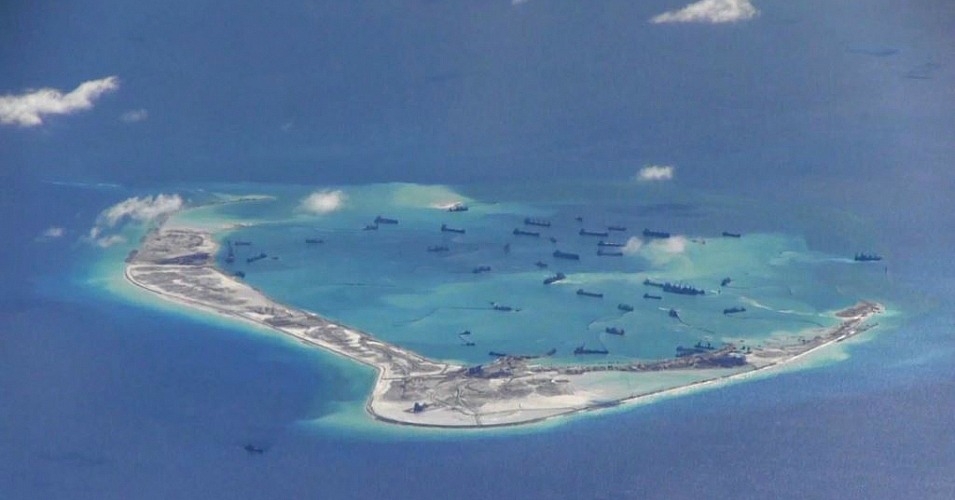Ruling in favor of the Philippines, tribunal court “cut the legal heart out of China’s claim” to the disputed marine region
By Lauren McCauley, staff writer for Common Dreams. Published 7-12-2016

Chinese dredging vessels seen in the waters around Mischief Reef in the disputed Spratly Islands in the South China Sea in this video image taken by a P-8A Poseidon surveillance aircraft provided by the U.S. Navy, May 21, 2015.
An international tribunal at the Hague overwhelmingly rejected China’s claims to the South China Sea on Tuesday, in a move that observers say is likely to stoke tensions between the Asian powerhouse and its primary rival, the United States.
The Permanent Court of Arbitration ruled that under the United Nations Convention on the Law of the Sea (UNCLOS), China’s actions have violated the sovereign rights of the Philippines, which brought the case to court. Further, the court ruled that China’s practice of dredging sand to build artificial islands on the region’s disputed reefs has caused “severe harm to the coral reef environment.”
Summarizing the ruling, Gareth Evans, Chancellor of the Australian National University and former Australian foreign minister, wrote Tuesday that “the tribunal cut the legal heart out of China’s claim that the sea is, in effect, a Chinese lake.”
He explains: “The PCA ruled that China’s ‘nine-dash line,’ a 1940s-era delineation that implies ownership by China of 80% of the South China Sea, is legally meaningless. It also made clear that China’s recent land-reclamation activity, turning submerged or otherwise uninhabitable reefs into artificial islands with airstrips or other facilities, confers no new rights to the surrounding waters or any authority to exclude others from sailing or flying nearby.”
However, the court has no powers of enforcement over the binding ruling, despite the fact that both China and the Philippines are signatories of the UNCLOS, and the Chinese government was quick to reject the finding as “naturally null and void”
Wang Xiaohui, editor-in-chief of news site China.org denounced the arbitration in an op-ed Tuesday as a “U.S.-led conspiracy.”
“For the U.S., sabotaging the relations between China and [Association of Southeast Asian Nations] countries is an effective way to hinder China’s development,” Xiaohui wrote, “apart from being a best solution with low cost and high efficiency to increase Southeast Asian countries’ dependence on it.”
Indeed, the Philippines is not the only other Pacific nation involved in the territory dispute. China has asserted its sovereignty “over maritime areas that span 3.5m square kilometers but are also claimed by Vietnam, Taiwan, Malaysia, Brunei, the Philippines and Japan,” theGuardian reports.
What’s more, this area is thought to contain abundant fisheries, “significant oil and gas reserves, and is a route for about $4.5tn (£3.4tn) in trade,” comprising as much as half of all commercial shipping lanes, the Guardian notes.
Under the banner of a “pivot to Asia,” the United States in recent years has routinely used warship and drone patrols in the region in an attempt to dissuade China’s territory claims—actions which have been interpreted as provocative.
The Guardian‘s Simon Tisdall argues that while the Philippines had hoped the court ruling would provide a “peaceful, international acceptable solution to its long-running maritime dispute with China,” it “may do the exact opposite.”
And now that China has publicly rejected the court ruling and said it will not comply, how the other parties react remains to be seen.
“If China takes a hardline path, or fails to moderate its behavior significantly in the months ahead, the case for further international pushback by countries like [Australia]— including freedom-of-navigation voyages within 12 nautical miles of Mischief Reef and other artificial islands in that category— will become compelling,” Evans writes.
“But right now,” he concludes, “it is in everyone’s interest to give China some space to adjust course and to reduce, rather than escalate, regional tensions.”

